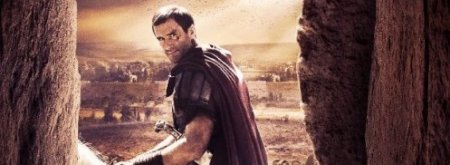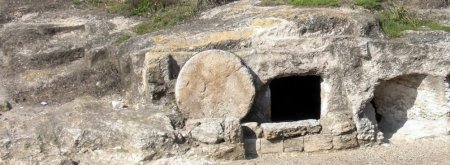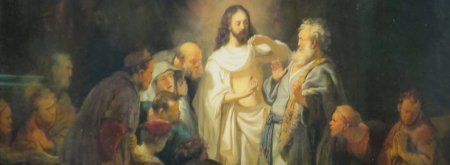The Resurrection Factor
The resurrection of Jesus Christ. The apostle Paul said, 'If Christ be not raised from the dead, then your faith is in vain.' Everything that Jesus taught, lived, and died for depended upon one thing, an empty tomb and His resurrection and His appearance to His followers. We have looked at many aspects of the resurrection starting with the crucifixion. We want to continue looking at the scriptures and looking behind what the scriptures are saying with some of the historical detail.
For example, it says that a large stone was rolled against the entrance of the tomb. Another account in the gospel said the stone was 'very large'. That phrase, in the Greek, saying 'very large' is kind of like going, 'Wow! Get a load of that stone!' In other words the stone was of such a size, it caused an unusual exclamation on the part of the people who visited the tomb. Now normally, what they would do is, they would roll the stone against the entrance, or, and this is probably what happened, there was just a large stone, a regular boulder they rolled against the entrance, or because it was a new tomb and maybe they hadn’t finished it yet because the description is not the normal one for the way they would roll the stone. Normally, they would have a slab of stone about this wide and about this tall [about a couple of feet wide and about 5 feet tall]. There would be a trough going up, a ledge alongside the front to the right of the entrance and they would place the stone there with a peg. Once they prepared the body and put it in there, all they had to do was pull the peg, the stone would roll down and lodge against a stone on the other side and seal the tomb. But the way the Greek describes the stone being rolled, it was probably more of a regular round boulder rolled up against it. Now it says it was a very large stone. In one of the oldest manuscripts that we have in the New Testament, within the text, within parentheses, meaning, it was added and it usually means it was the thought of that day. In Mark 16, it says a stone and then in parentheses, that could not be moved by fifteen men, end of parentheses. I think the emphasis of that phrase shows that it was an extremely large stone.
I had been lecturing at a very famous engineering college and I had spoken on the resurrection. Several of the professors who heard me speak later went to Israel with that university and they had remembered what I had said about the size of the stone. So as engineers, they took the type of stone that were over there, used in the day of Christ, and they calculated the size of the stone needed to roll against a four and a half to five foot doorway that the tombs had and they sent me about a five page letter with all the technical drawings and details. They put it in the last paragraph, in rather simple English when they said the stone would have to have a minimum weight of one and a half to two tons. No wonder they said an extremely large stone.
The body of Christ was placed in the tomb and then the stone was rolled against the entrance. After that it says that a guard unit was placed on the tomb. The Jewish leaders went to Pilate and they said look, 'When that deceiver was still alive He said in three days that grave would be empty.' They said, 'We better make it secure or He will pull off another deception and the second deception would be worse than the first.' So Pilate said, 'A guard you have.' Now here are the Jewish authorities coming to Pilate, and then Pilate said to the Jewish authorities when they asked for a guard, said, 'A guard you have, now go make it secure'. There can be several legitimate interpretations of that phrase. There are two alternatives I believe. One: does it refer to the temple guard, the temple police, or does it refer to the Roman guard? My conviction is that it refers to the Roman guard. But even if it didn’t it’s no big deal, it’s not that critical or even an issue. For example, with the temple police, there were two hundred and seventy temple police. They were divided up into small units of anywhere from ten to twenty-seven each and once in a while, four people. If they were caught sleeping or failed in their duty, they were burned; they were set on fire with their own clothes. There was severe discipline or punishment by the head of the temple and the Jewish leaders. But I don’t believe it was the temple police. Now there are several reasons for that. It says that after the resurrection that the guard went to the High Priest. You say, 'Well see they went to the High Priest, it shows they were the temple priest.' No, I do not believe that is what it shows because here is what happened. From the time they went to the temple leaders, the temple leaders, I believe, had to send a commission out to the tomb because they came and they told the Jewish leaders what had happened. They said, 'We do not know what happened here. But all we know is the tomb is empty and there was this earthquake and this bright light and all'. Well they didn’t believe them. I believe they sent a commission out to the tomb. They examined it, came back and they said, something unusual happened. They could not find a fault in the guards’ explanation. They somehow must have been convinced that they weren't derelict. And so they bribed the guards, it says they gave them money. Now if it had been the temple police, I do not believe the Jewish leaders would have bribed their own police. They would have threatened them with death; they would have threatened them with severe punishment if they did not spread the rumor. And they said, 'Look, take this money and spread the rumor among the people that while you were asleep…' And for them to say that, boy they had to be desperate. Nobody would believe that. They did not believe it then, they don’t believe it now. They had no other story they could tell. They said take this money, they bribed them, and said spread it abroad that while you were asleep the disciples came in and stole the body and have run around the countryside proclaiming Christ is alive. And then the Jewish leader made a phrase that I believe indicates or shows it was the Roman guard unit, not the temple police. When the Chief Priest said, 'And if it comes to the Governor’s ears', in other words, if the Governor hears about what happens, 'we will keep you from being cut off or killed'. I cannot find anywhere historically where in any way the Roman Governor had anything to do with the temple police. There was no relationship – no matter how the temple police might have failed, the Governor could not have acted against them. I believe this is what happened. The Jewish leaders got the Roman guard unit in the first place. And so when the tomb was empty and Christ had been raised from the dead, the guard unit panicked. And it says, some of them stayed at the tomb and the others went to the High Priest. Now the reason they went to the High Priest, they knew the High Priest had influence with the Roman leader, with Pilate. They had gotten a guard in the first place. And so then the Jewish leaders bribed the Roman guard and said, look we have influence with Pilate and when this comes to his ears, we will keep you from being killed. So I am of the conviction, it was a Roman guard unit not the temple police but it doesn't really matter. What was a Roman guard unit? When it says here 'A guard you have, go make it secure' (Matthew 27:65-66), the Greek grammar is like saying, okay, you have this, I give it to you, now you go make it secure. So here is the Roman guard, you go with the Roman guard and they will make it secure. Now what was a Roman guard, a Custodian?
There was a man by the name of Flavius Vegetius Renatus. He was a Roman historian that lived a number of years after the time of Christ when the Roman army and discipline started to deteriorate. So Flavius Vegetius Renatus wrote an institute called The Military Institutions of the Romans to the Emperor to encourage the Emperor to instill the methods of offensive and defensive warfare of the Romans at the time of Christ so that they might preserve the integrity of the Roman Empire. In this book it describes the Roman Custodian, the Roman Guard. It was given to me by the head of the United States Military, the Joint Chief of Staff. And he gave it to me after he heard me speak on the resurrection. And he said we use the methods in this institute in order to train our elite troops called the Green Berets. So he gave me the book as a gift because it was printed by the military. It describes what a Roman Custodian is. It was not a one, two or three man force. A Roman Custodian was a sixteen man security unit. Each man was a fighting machine. Each man had usually three to five different weapons on them. They were able to protect six square yards, each individual, against superior force. The sixteen men, in the square of four on each side, were supposed to, and their reputation was, that they could protect that ground from an entire battalion. They were that well trained. In fact, they even used psychological warfare. It describes that they would often have black and purple feathers on these massive helmets. And the black and purple feathers would go up two and a half feet and the reason is, at a distance it made them look twice as big as they really were. And you read the descriptions of their enemies, how just the sight of the Roman Custodian struck fear into a person’s heart. Now I believe that sixteen of these men were placed at the tomb of Jesus Christ. You can find some accounts where four individuals were placed, in other words, one fourth of a Custodian, but there's no indication that is what happened here. Especially when it says, after the resurrection some of the guard unit remained at the tomb and the others went into the city to see the High Priest. I believe that indicates it was a pretty good size, multiple guard units. Now normally the way they were dispensed, the sixteen men, say at the tomb, you would have four units in the group of sixteen. The first unit was awake in a semi-circle in front of what they were to protect. The other twelve with their heads facing in were asleep in a semi-circle in front of them. Then every four hours, with the temple police it was every six hours they changed, with the Roman Custodian, every four hours, they woke up another unit or another unit that was rested took the place immediately in front of what they were protecting.
So I believe here we have a sixteen-man security unit that was placed at the tomb of Jesus Christ. You say, 'Why would they do that?' Well all you have to do is read the account. I mean when you have the political problem, the Roman problem, the Jewish problem, the economic problem, the religious problem – Pilate had a problem. He had to make sure that that tomb remained occupied. Because if it did not it could well reach the emperor’s ears and Pilate would be removed from power. So they took extra precaution to make sure it was solid.
Then it says that they put a seal on the tomb. The Roman seal could only be put on in the presence of the Roman guard. The seal was made up of two pieces, of rawhide and then there were usually clay packs where the rawhide would touch the outer rim of the tomb of the door. In the center there was a large impact of clay and they would take the Roman insignia, which often would be a ring and they would embed it in each piece of the plastic [clay]. This is important to understand. The seal wasn’t put there to make it more difficult to break it or to remove something or to steal something. You could easily break the seal. The seal did two things. First of all, it was an authenticating device. When the Roman guard unit placed the seal on something and the insignia embedded in it, they put their lives on the line that what they were to protect was there, in this case, the body of Christ. They put their lives on the line. Then second, the seal was a security symbol in this sense – it represented the power and the might of the Roman Empire. People feared the breaking of that seal, because if that seal was broken every security force of the Roman Empire was thrown into finding that man or men. When they were found, now think of this, they were crucified; those who broke the seal were crucified upside down. And when they were crucified, trumpets played throughout that city so everyone could be aware of the severe discipline of the Romans when it came to breaking the seal.
This was just some of the security: a solid rock tomb; one entrance four and a half to five feet tall. That’s why when John ran to the tomb, it says he leaned over to look in. Why? He didn’t want a headache, the entrance was only four and a half to five feet tall. Then there was a hundred and something pound encasement with aromatic spices and cement consistency around the body. Then they rolled a one and a half to two ton stone against the entrance of the tomb. Then they placed a Roman guard unit or the temple police there – but with the temple police, the seal makes no sense. Then they placed a seal on the tomb. Those were just some of the precautions taken. But something happened, something happened that all over the world for two thousand years, almost every book carries the date that refers back to the resurrection of Christ and the time of Christ. Something happened that took twelve men, turned their lives upside down and ten or eleven of the twelve men
died martyrs’ deaths and the other died in exile. The only explanation that I have seen is that on the third day, the tomb was empty and Christ was raised from the dead and appeared to many of His followers.
Let’s look at what happened after the resurrection or during the resurrection. It says that the seal was broken. For anyone to break that seal it took a lot of courage because they literally feared the breaking of the Roman seal because they would be killed, they would be hunted down and killed. Everything you know about the disciples, the apostles, they never would have had the courage or the nonsense to even begin to do that because they would immediately have been found out. Second, you have the Roman Guard unit. When that guard unit failed in its duty – if they fell asleep, left their position, or failed in any way – there are a number of historical sources that go back and describe what happens. Many of them are stripped of their own clothes, they are burned alive in a fire started with their own garments or they are crucified upside down. The Roman Guard unit was committed to discipline and they feared failure in any way. That’s how Rome could conquer so many lands and hold them, the people, in obedience, because of the discipline of the Roman Army and the Roman Guard unit.
The breaking of the Roman seal, the Guard fleeing the situation, let me tell you, it had to be terrifying for them to do that. It had to be more than some earthquake and an angel of the Lord coming and rolling away the stone. They realized, they went in, the surprise they must have had when they looked in and the body was gone. The body was gone. Yet what amazed them, because as they looked over, here were the grave clothes folded up and placed in a certain place within the tomb. They were convinced that something very unusual had happened. And that’s why they immediately, half of them stayed there and the others fled and went to the High Priest to see what could be done. And then the High Priest bribed them to spread abroad the story that while they were sleeping, and nobody believed it then, and look nobody believes that now. Anyone who has taken time to examine the historical evidence – but they spread abroad, and the Jews started to spread that abroad to try to protect themselves but it backfired on them and we’ll see how later.
When they approached the tomb, in Matthew, Mark, Luke and John, in the original, it’s lost in the English, Russian, German, and French translations, but in the Greek, every time somebody approached that tomb after the resurrection, an amazing statement, not so much a statement, an exclamation was made about the position of that one and a half to two ton stone. Let me show you what I mean. In Matthew, Mark, Luke and John, one of the accounts says, the large stone was rolled away and it uses a combination of Greek words and terms that means away from, in the sense of distance. But here it’s interesting, you would normally roll the stone away from the entrance of the tomb a little bit to steal the body if you were going to. But the account says that the stone was rolled away at a large distance but not just from the entrance but the entire tomb. And then the other account uses a Greek word that the stone was rolled up a slope or an incline down to the front and there is no way that word could have been used unless there was an incline going away from the tomb. It says the stone was rolled away from, up an incline, from the entire sepulcher. And then the account in the gospel of John says, it uses a Greek word, 'airō', which means to pick up and to carry away. That is why, every time somebody approached, they made an unusual statement about the position of the stone because it was away from, not just the entrance, but the entire sepulcher, up a slope, looking like it had been picked up and carried away. And I believe when the High Priest was confronted with the Roman Guard unit and they sent a commission to examine it one of the first things they saw was the stone. They said, 'Wait a minute, how could that stone get way up there if somebody was just going to steal the body?' But that was probably just one of the many unusual things around the tomb of Jesus that convinced the Jewish leaders. Something happened here that we cannot explain. The tomb was empty. The tomb was empty.
First of all in the book, The Resurrection Factor, I document from a number of Jewish sources, going all the way back to the first and second century that makes statements that the tomb was empty. Now look, when you get your opponents, you might say, when you get those that disagree with you, to make a positive statement about what you believe, that’s pretty solid ground. And here is a hostile voice saying, the tomb was empty. When you get the Jews doing that, you’re on pretty solid ground. Also, think this through, where was Christianity launched? The city of Jerusalem. If Christ had not been raised from the dead and the tomb wasn’t empty, where would have been the hardest place on earth to convince anyone that Christ had been raised from the dead and Christianity was true? Jerusalem. Look, a fifteen to twenty minute walk by anyone could confirm that the tomb was not empty if it was not. But the apostles went right back to the hardest place on earth to convince anyone that Christ had been raised from the dead if he hadn’t been – Jerusalem. And that is where they went and preached. I believe the very launch of Christianity in Jerusalem confirms that the tomb was empty, that on the third day He was raised from the dead.
We have already covered a lot of material. We’ve covered the whole background: His predictions of the resurrection; the crucifixion; how He was crucified; He was buried. Four executioners signed His death warrant and then they placed Him in a solid rock tomb of one entrance four and a half to five feet tall; a hundred and something pound encasement around the body; a one and a half to two ton stone rolled against the entrance; a Roman Guard unit put there; a seal was placed on it. But something happened, the seal was broken at the threat of death; the stone was rolled up a slope away from, not just the entrance, but the entire sepulcher looking like it had been picked up and carried away; the guard units, some of them stayed there, the others fled to the High Priest who bribed them to say, look, we do not know how to explain this, so you take this money, spread it abroad that while you were sleeping [the disciples came in and stole the body and when it comes to the governor’s ears, we’ll keep you from being killed.
On the third day, the tomb was empty. That is an historical fact.
Go to Part 4
© 2009 Josh McDowell Ministry
Josh McDowell Ministry, 2001 West Plano Parkway, Suite 2400, Plano, TX 75075, USA
Tel: +1 972 907 1000 www.josh.org
This resource is reproduced here by the kind permission of the Josh McDowell Ministry.



